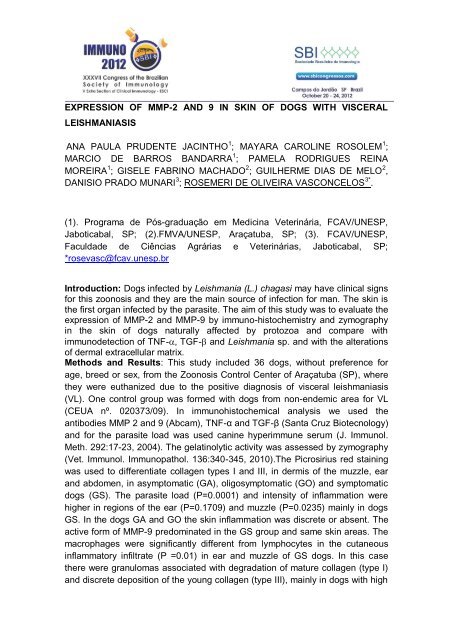immunology of infectious and parasitic diseases - XXXVII Congress ...
immunology of infectious and parasitic diseases - XXXVII Congress ...
immunology of infectious and parasitic diseases - XXXVII Congress ...
Create successful ePaper yourself
Turn your PDF publications into a flip-book with our unique Google optimized e-Paper software.
EXPRESSION OF MMP-2 AND 9 IN SKIN OF DOGS WITH VISCERAL<br />
LEISHMANIASIS<br />
ANA PAULA PRUDENTE JACINTHO 1 ; MAYARA CAROLINE ROSOLEM 1 ;<br />
MARCIO DE BARROS BANDARRA 1 ; PAMELA RODRIGUES REINA<br />
MOREIRA 1 ; GISELE FABRINO MACHADO 2 ; GUILHERME DIAS DE MELO 2 ,<br />
DANISIO PRADO MUNARI 3 ; ROSEMERI DE OLIVEIRA VASCONCELOS 3* .<br />
(1). Programa de Pós-graduação em Medicina Veterinária, FCAV/UNESP,<br />
Jaboticabal, SP; (2).FMVA/UNESP, Araçatuba, SP; (3). FCAV/UNESP,<br />
Faculdade de Ciências Agrárias e Veterinárias, Jaboticabal, SP;<br />
*rosevasc@fcav.unesp.br<br />
Introduction: Dogs infected by Leishmania (L.) chagasi may have clinical signs<br />
for this zoonosis <strong>and</strong> they are the main source <strong>of</strong> infection for man. The skin is<br />
the first organ infected by the parasite. The aim <strong>of</strong> this study was to evaluate the<br />
expression <strong>of</strong> MMP-2 <strong>and</strong> MMP-9 by immuno-histochemistry <strong>and</strong> zymography<br />
in the skin <strong>of</strong> dogs naturally affected by protozoa <strong>and</strong> compare with<br />
immunodetection <strong>of</strong> TNF-, TGF- <strong>and</strong> Leishmania sp. <strong>and</strong> with the alterations<br />
<strong>of</strong> dermal extracellular matrix.<br />
Methods <strong>and</strong> Results: This study included 36 dogs, without preference for<br />
age, breed or sex, from the Zoonosis Control Center <strong>of</strong> Araçatuba (SP), where<br />
they were euthanized due to the positive diagnosis <strong>of</strong> visceral leishmaniasis<br />
(VL). One control group was formed with dogs from non-endemic area for VL<br />
(CEUA nº. 020373/09). In immunohistochemical analysis we used the<br />
antibodies MMP 2 <strong>and</strong> 9 (Abcam), TNF-α <strong>and</strong> TGF-β (Santa Cruz Biotecnology)<br />
<strong>and</strong> for the parasite load was used canine hyperimmune serum (J. Immunol.<br />
Meth. 292:17-23, 2004). The gelatinolytic activity was assessed by zymography<br />
(Vet. Immunol. Immunopathol. 136:340-345, 2010).The Picrosirius red staining<br />
was used to differentiate collagen types I <strong>and</strong> III, in dermis <strong>of</strong> the muzzle, ear<br />
<strong>and</strong> abdomen, in asymptomatic (GA), oligosymptomatic (GO) <strong>and</strong> symptomatic<br />
dogs (GS). The parasite load (P=0.0001) <strong>and</strong> intensity <strong>of</strong> inflammation were<br />
higher in regions <strong>of</strong> the ear (P=0.1709) <strong>and</strong> muzzle (P=0.0235) mainly in dogs<br />
GS. In the dogs GA <strong>and</strong> GO the skin inflammation was discrete or absent. The<br />
active form <strong>of</strong> MMP-9 predominated in the GS group <strong>and</strong> same skin areas. The<br />
macrophages were significantly different from lymphocytes in the cutaneous<br />
inflammatory infiltrate (P =0.01) in ear <strong>and</strong> muzzle <strong>of</strong> GS dogs. In this case<br />
there were granulomas associated with degradation <strong>of</strong> mature collagen (type I)<br />
<strong>and</strong> discrete deposition <strong>of</strong> the young collagen (type III), mainly in dogs with high



